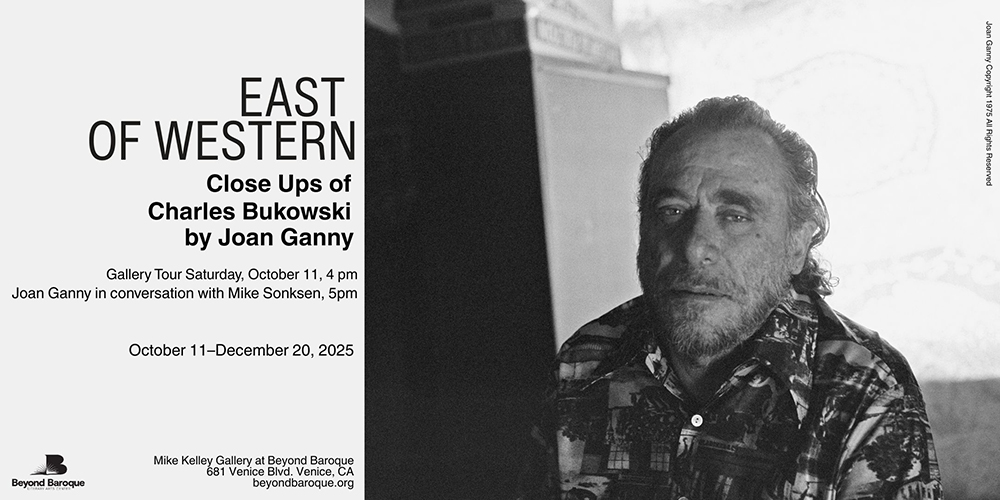|
FOR IMMEDIATE RELEASE:
East of Western: Close Ups of Charles Bukowski by Joan Ganny
October 11 – December 20, 2025
Gallery Tour: Joan Ganny | October 11, 2025 | 4:00 PM
Opening Conversation: Joan Ganny & Mike Sonksen | October 11, 2025 | 5:00 PM

|
Beyond Baroque is proud to present East of Western: Close Ups of Charles Bukowski by Joan Ganny, an extraordinary photography exhibition offering an intimate portrait of the legendary Los Angeles poet. Opening October 11, 2025, at the Mike Kelley Gallery, this landmark show marks the first U.S. exhibition of many of Ganny’s images, including both iconic and never-before-seen photographs captured during her unprecedented access to Bukowski.
Shot on vintage Kodak Tri-X and Kodachrome film, Ganny’s photographs illuminate “the man behind the myth”, revealing Bukowski in rare moments of reflection, humor, and candor. The collection includes close-up portraits and vivid glimpses of his everyday life, creating one of the most personal visual records of the poet ever assembled.
“Bukowski is one of Los Angeles’s most iconic literary figures, and Joan Ganny’s photographs bring us closer to the texture of his life and work than almost any other record we have,” said Jimmy Vega, Interim Executive Director of Beyond Baroque. “Hosting this exhibition at Beyond Baroque, L.A.’s historic home for poetry, is a way of opening new conversations about his influence.”
For Ganny, the exhibition represents both a return and a revelation. “It is thrilling to bring Charles Bukowski back to Los Angeles, which is where it all began. It is also a bit of a homecoming for me, having relocated to Europe in the late 1980s. I had no idea when I reluctantly agreed to initially photograph him for a friend’s article in Rolling Stone (see artist statement) half a century ago, that the work would have such an impact abroad, as well as decades after his death. Some of the images seemed too serious at the time, too personal, and never were printed. I rediscovered them when Black Sparrow publisher, the late John Martin, called me after Hank’s death and asked if I had any photos he hadn’t seen. And a year ago, preparing for an exhibition as part of an international Bukowski symposium at the University Bordeaux Montaigne, I found the color shots in my archive, which, like the black and white images, are being shown in America for the first time.”
The exhibition will open with a conversation between Joan Ganny and poet-scholar Mike Sonksen on Bukowski’s complex persona and body of work. Additional programs throughout the run will feature public readings of Bukowski’s poems, conversations about his literary and cultural legacy, and live performances by poets working in his tradition.
Special limited editions of oversized A0 poster prints and 50x70cm fine art photographs—available in both black and white and color—have been created exclusively for Beyond Baroque visitors. These works, along with custom Bariet prints, postcards, and posters, will be available for purchase through the Beyond Baroque Bookshop for the duration of the exhibition.
About Joan Ganny
Joan Ganny makes photographs about the people she writes about. She was born in New York City, raised in Hollywood, and has been based in Amsterdam since 1987. Her mother Adele was a glamour photographer who put a camera in her hand when she was five. Her father gave her a typewriter when she was eight. Joan started her career as a broadcast and print journalist in the mid-1970s, freelancing for the LA Times, Los Angeles magazine, and Penthouse, making interviews with Henry Miller, Joan Baez, and Muhammad Ali, among many others. She also documented one of the first homeless women in southern California, which changed her life and was the stimulus for her to eventually emigrate to Europe. She is an award-winning children’s book author (Elusive Moose, Hidden Hippo; Barefoot Books), jazz and pop lyricist, and has published three chapbooks. In 2021, she was the editor and contributor to INSIDE BLACK, a book that explored the many facets of the powerful color. She recently completed a memoir, One-Way Ticket and continues using her analogue cameras to make portraits of people in their environments.
|
|

